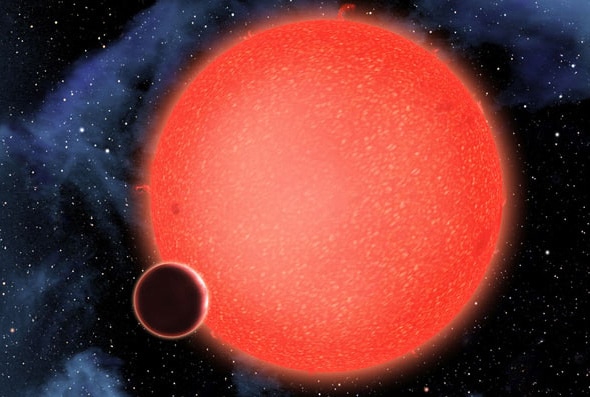Create a free profile to get unlimited access to exclusive videos, sweepstakes, and more!
The Closest Known Exoplanet? Maybe …

In 1992, the first planets outside the solar system were discovered, orbiting the dead cinder of a supernova. Three years later, 51 Peg was found, the first exoplanet orbiting a Sun-like star. Now, after a decade of searching, we have a roster of nearly 2,000 such planets, alien worlds circling alien stars.
They come in many varieties, with some being huge, Jupiter-like behemoths, and others far closer in size to our own hospitable planet. We’ve found them around distant stars hundreds of light years away, and some much closer.
And that brings us to a newly found planet just announced: Gliese 15Ab. It has a mass of about five times Earth’s, which is interesting in and of itself; that makes it a super-Earth, if you will, a planet bigger than us but perhaps not quite massive enough to gravitationally attract a thick atmosphere. We don’t know much about what it’s like, but it’s probably not a gas giant.
But that’s not the interesting bit. The interesting bit is that its host star, Gl 15A, is a mere 11.7 light years from Earth. It’s one of the 20 closest stellar systems known, making GL 15Ab quite possibly the closest known exoplanet!
Gliese 15 is a binary star, two cool, dim red dwarfs orbiting each other. Red dwarfs are the most common type of star in the galaxy, but they’re so intrinsically faint that not a single one is visible to the naked eye; you need a telescope to see them. The closest star to the Sun we know of, Proxima Centauri, is only 4.2 light years away and even then too faint to see without using at least good binoculars.
Gliese 15 A and B (as the two stars are called, or just Gl 15A and B for short) orbit each other at a distance of about 22 billion kilometers, which is five times the distance Neptune orbits the Sun, so they’re pretty far apart. The planet discovered has a very tight orbit around the brighter of the two stars, Gl 15A, circling it a mere 11 million kilometers out. That’s close. Even though the star itself is a dim bulb, the planet is so near to it that it’s heated to at least the boiling point of water, and possibly hotter.
Gl 15Ab was found using what’s called the Doppler shift (or reflex velocity) method. Because the planet has significant mass, as it orbits its parent star in a big circle, the star itself makes a smaller circle every orbit, too. They actually each orbit their mutual center of mass, called the barycenter, like two kids facing each other, holding hands, and swinging each other around. If this sounds familiar, I just wrote about this recently because Pluto and its largest moon, Charon, do the same thing, and this was seen by the approaching New Horizons space probe.
We don’t actually see the star and planet move, but as the star approaches us in its orbit its light gets slightly blue-shifted, and as it moves away the light red shifts. The change is incredibly small, but the team of astronomers used the huge Keck 10-meter telescope with an extremely high-resolution detector. Their observing campaign has gone on for 11 years, enough to detect the planet pretty well. To be clear, they didn’t see the planet directly; they only saw its effect on the star. But this method has proven out many times, and is quite reliable.
The amount the planet can tug on its star depends on its mass, which is how they found the planet to have 5.35 ±0.75 times the mass of Earth, and by measuring the period of the oscillation determined its year to be just 11.44 Earth days long. That’s how they know it orbits the star so closely; that’s a short year!
We’re still new at all this, the finding of alien worlds. But we’re pretty good at it. We know of enough to start looking at them statistically, as a group, able to make some solid extrapolations. Given what we’ve seen so far, we think there are billions of planets in our galaxy alone. Billions! It’s like a Star Trek fever dream come true.
Given those odds, it’s not terribly surprising to find a planet so close to home. I’ll note that this planet isn’t technically confirmed; that is, also found by another team of astronomers or also seen using other methods (like undergoing transits). Still, this observation looks pretty solid, and if so this makes it one of if not the closest known exoplanets. A handful of other planet candidates have been found that are closer, but none is confirmed. There are fewer than 30 known stars and brown dwarfs (substellar objects that are similar to stars but smaller) closer than Gliese 15; many are in multiple systems, binaries or trinaries, so it’s entirely possible we’ll find and confirm a closer planet still.
But even with all that, this goes to show that the sky is likely filled with planets, and many of them are pretty close to us in a cosmic sense. It also shows just how hard it is to find them! Eleven years of searching with one of the largest telescopes on Earth, and it was still a difficult task. But we’re getting better at this. If there are more, closer planets out there, we’ll find ‘em.
Tip o’ the warp nacelle to Dan Vergano.














